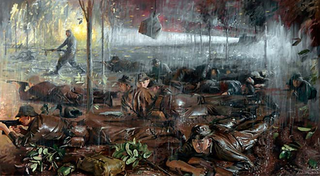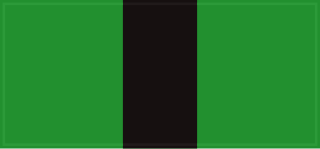
HMAS Sydney (R17/A214/P214/L134) was a Majestic-class light aircraft carrier operated by the Royal Australian Navy (RAN). She was built for the Royal Navy and was launched as HMS Terrible (93) in 1944, but was not completed before the end of World War II. The carrier was sold to Australia in 1947, completed, and commissioned into the RAN as Sydney in 1948.

The Royal Australian Regiment (RAR) is the parent administrative regiment for regular infantry battalions of the Australian Army and is the senior infantry regiment of the Royal Australian Infantry Corps. It was originally formed in 1948 as a three battalion regiment; however, since then its size has fluctuated as battalions have been raised, amalgamated or disbanded in accordance with the Australian government's strategic requirements. Currently, the regiment consists of seven battalions and has fulfilled various roles including those of light, parachute, motorised and mechanised infantry. Throughout its existence, units of the Royal Australian Regiment have deployed on operations in Japan, Korea, Malaya, Borneo, Vietnam, Somalia, Rwanda, Cambodia, East Timor, the Solomon Islands, Iraq and Afghanistan.

The Battle of Long Tan took place in a rubber plantation near Long Tân, in Phước Tuy Province, South Vietnam, during the Vietnam War. The action was fought between Viet Cong (VC) and People's Army of Vietnam (PAVN) units and elements of the 1st Australian Task Force.

The 4th Battalion, Royal Australian Regiment was an infantry battalion of the Australian Army, forming part of the Royal Australian Regiment and eventually Special Operations Command. The battalion was formed on 1 February 1964, converted to a special forces unit on 01 February 1997, and was renamed the 2nd Commando Regiment on 19 June 2009.

6th Battalion, Royal Australian Regiment is a mechanised infantry battalion of the Australian Army. It was originally raised in Brisbane, Queensland, on 6 June 1965 and has since then served in a number of overseas deployments and conflicts including South Vietnam, East Timor, Iraq and Afghanistan. During the Vietnam War, the battalion earned a US Presidential Unit Citation from the United States when members from 'D' Company participated in the Battle of Long Tan on 18–19 August 1966. The battalion is currently based at Gallipoli Barracks in Brisbane and forms part of the 7th Brigade.

The 1st Australian Task Force was a brigade-sized formation which commanded Australian and New Zealand Army units deployed to South Vietnam between 1966 and 1972. 1 ATF was based in a rubber plantation at Nui Dat, 8 kilometres (5.0 mi) north of Bà Rịa in Phuoc Tuy Province and consisted of two and later three infantry battalions, with armour, aviation, engineers and artillery support. While the task force was primarily responsible for securing Phuoc Tuy Province, its units, and the Task Force Headquarters itself, occasionally deployed outside its Tactical Area of Responsibility.

The 3rd Battalion, Royal Australian Regiment is a mechanised infantry battalion of the Australian Army, based in Kapyong Lines, Townsville as part of the 3rd Brigade. 3 RAR traces its lineage to 1945 and has seen operational service in Japan, Korea, Malaya, Borneo, South Vietnam, Rifle Company Butterworth, East Timor, the Solomon Islands, Afghanistan and Iraq.

1st Battalion, Royal Australian Regiment is a regular motorised infantry battalion of the Australian Army. 1 RAR was first formed as the 65th Australian Infantry Battalion of the 34th Brigade (Australia) on Balikpapan in 1945 and since then has been deployed on active service during the Korean War, the Malayan Emergency, the Vietnam War, Unified Task Force in Somalia, East Timor, Iraq War and Afghanistan. Additionally, the battalion has deployed on peacekeeping and other operations to a number of countries including Japan, Rifle Company Butterworth, Timor Leste, Solomon Islands, Tonga and the Philippines. 1 RAR remains one of the Australian Army's most readily deployed units sending individuals and detachments to domestic, regional and other enduring operations. The battalion is currently based in Coral Lines at Lavarack Barracks, Townsville, Queensland, where it forms part of the 3rd Brigade.

The Battle of Coral–Balmoral was a series of actions fought during the Vietnam War between the 1st Australian Task Force and the North Vietnamese People's Army of Vietnam (PAVN) 7th Division and Viet Cong (VC) Main Force units, 40 kilometres (25 mi) north-east of Saigon. Following the defeat of the PAVN/VC Tet offensive in January and February, in late April two Australian infantry battalions—the 1st and 3rd Battalions of the Royal Australian Regiment (RAR)—with supporting arms, were again deployed from their base at Nui Dat in Phước Tuy Province to positions astride infiltration routes leading to Saigon to interdict renewed movement against the capital. Part of the wider allied Operation Toan Thang I, it was launched in response to intelligence reports of another impending PAVN/VC offensive, yet the Australians experienced little fighting during this period. Meanwhile, the PAVN/VC successfully penetrated the capital on 5 May, plunging Saigon into chaos during the May Offensive in an attempt to influence the upcoming Paris peace talks scheduled to begin on the 13th. During three days of intense fighting the attacks were repelled by US and South Vietnamese forces, and although another attack was launched by the PAVN/VC several days later, the offensive was again defeated with significant losses on both sides, causing extensive damage to Saigon and many civilian casualties. By 12 May the fighting was over, and the PAVN/VC were forced to withdraw having suffered heavy casualties. US casualties were also heavy and it proved to be their most costly week of the war.

The 2nd Battalion, Royal Australian Regiment is an amphibious light infantry battalion of the Australian Army part of the 1st Division Amphibious Task Group based at Lavarack Barracks in Townsville.

The 5th Battalion, Royal Australian Regiment is a regular motorised infantry battalion of the Australian Army. Originally established in 1965 it would serve two tours of South Vietnam before it was linked with the 7th Battalion to form the 5th/7th Battalion, Royal Australian Regiment in 1973. In late 2006 the two units were de-linked, and 5 RAR again joined the Australian Army's order of battle in its own right. It has since served in Iraq, East Timor and Afghanistan.

The 7th Battalion, Royal Australian Regiment is a regular infantry battalion of the Australian Army. It was originally raised in 1965 as part of Australia's commitment to the Vietnam War and it eventually served two tours in Vietnam in 1967 and 1971. In 1973, following Australia's withdrawal from the conflict, the battalion was amalgamated with the 5th Battalion, Royal Australian Regiment to form the 5th/7th Battalion, Royal Australian Regiment.

The 8th Battalion, Royal Australian Regiment was an Australian Army Regular infantry battalion. The battalion was formed in July 1966 as part of an expansion of the Australian Army in the mid-1960s due to the perceived threat of Communism in southeast Asia. Initially the battalion was sent to Malaysia in 1967, before later being sent to South Vietnam as part of Australia's commitment to the Vietnam War. Between November 1969 and October 1970 the battalion undertook operations as part of the 1st Australian Task Force, before being brought back to Australia. In October 1973, after Australia's involvement in Vietnam officially ended, the battalion was amalgamated with 9 RAR to form 8/9 RAR.

The 9th Battalion, Royal Australian Regiment was a Regular light infantry battalion of the Australian Army. The battalion was raised in November 1967 and deployed to South Vietnam as part of Australia's commitment to the Vietnam War in November 1968. 9 RAR served a year-long tour of duty based out of Nui Dat conducting operations mainly in Phuoc Tuy Province as part of the 1st Australian Task Force. The Battalion returned to Australia in November 1969 and was reformed at Enoggera, Queensland in January 1970 as part of the 6th Task Force, attached to the 1st Division. On 31 November 1973, following the withdrawal of Australian forces from South Vietnam and subsequent reduction of the Australian Army, the battalion was linked with the 8th Battalion, Royal Australian Regiment to form the 8th/9th Battalion, Royal Australian Regiment.

Operation Coburg was an Australian and New Zealand military action during the Vietnam War. The operation saw heavy fighting between the 1st Australian Task Force and North Vietnamese People's Army of Vietnam (PAVN) and Viet Cong (VC) forces during the wider fighting around Long Binh and Bien Hoa.
Major General Alan Lindsay "Alby" Morrison, AO, DSO, MBE was a senior officer in the Australian Army. A graduate of the Royal Military College, Duntroon, Morrison was commissioned as an infantry officer in 1947 and served on occupation duties in Japan as part of the British Commonwealth Occupation Force. He later served with the 3rd Battalion, Royal Australian Regiment, seeing combat as a platoon commander during the Korean War. After serving on the headquarters of the 28th Commonwealth Brigade, he led the 9th Battalion, Royal Australian Regiment, during its combat tour during the Vietnam War. His later appointments included commander of the 1st Brigade and commandant of Duntroon. He retired from the Army in 1981 after 36 years of service, and died in 2008 at the age of 80.

Major General Ronald Laurence Hughes, was a senior infantry officer in the Australian Army, seeing service during the Second World War, the Korean War and the Vietnam War. Joining the Australian Army in 1937, after graduating from the Royal Military College, Duntroon in 1939 he served in New Guinea and Borneo during the Second World War. He commanded the 3rd Battalion, Royal Australian Regiment during the static phase of the war in Korea in 1952–1953. Later, he commanded the 1st Australian Task Force in South Vietnam in 1967–68, during some of the heaviest fighting of the war experienced by the Australians. He subsequently filled a number of senior command and staff positions before retiring in 1977.

The Long Tan Cross is a memorial which was erected by the 6th Battalion, Royal Australian Regiment on 18 August 1969 to mark the site of the Battle of Long Tan, which was fought three years earlier during the Vietnam War. While the cross was removed following the Communist victory in 1975 and used to commemorate a priest, it was recovered by the Đồng Nai Province Museum in 1984 and placed on display. A replica cross was also erected on the battlefield during the 1980s, and is frequently visited by Australian Vietnam War veterans. The original Long Tan Cross was gifted to Australia in 2017 and placed on permanent display at the Australian War Memorial in Canberra.

The order of battle of Australian forces during the Vietnam War consisted of a small group of military advisors from 1962, but grew to include an infantry battalion based in Bien Hoa in 1965. This force was then replaced by a two- and later three-battalion task force with supporting arms based at Nui Dat which operated primarily in Phuoc Tuy Province between 1966–71, with logistic elements at Vung Tau. Airforce units committed initially consisted of transport aircraft, but were followed by helicopters and later bombers, while naval forces included destroyers and transport vessels. With the size of Australian forces in Vietnam reaching a peak in early 1968, a drawdown commenced in late 1970, with the bulk withdrawn by early 1972. The last elements returned to Australia in 1973. In total, around 50,000 Australians served during the Vietnam War, including 42,437 members of the Australian Army, 3,310 from the Royal Australian Navy (RAN), and 4,443 from the Royal Australian Air Force (RAAF), with casualties including 519 killed and 2,348 wounded.
The Royal New Zealand Infantry Regiment contributed companies to the 1st Australian Task Force in the Vietnam War.





















